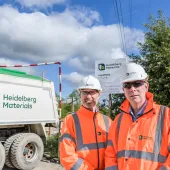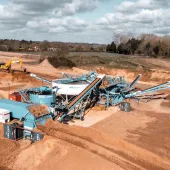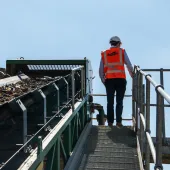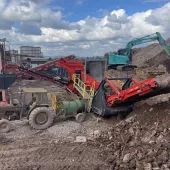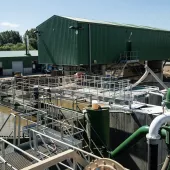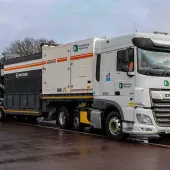CDE Washing Plant installation for William Thompson & Son
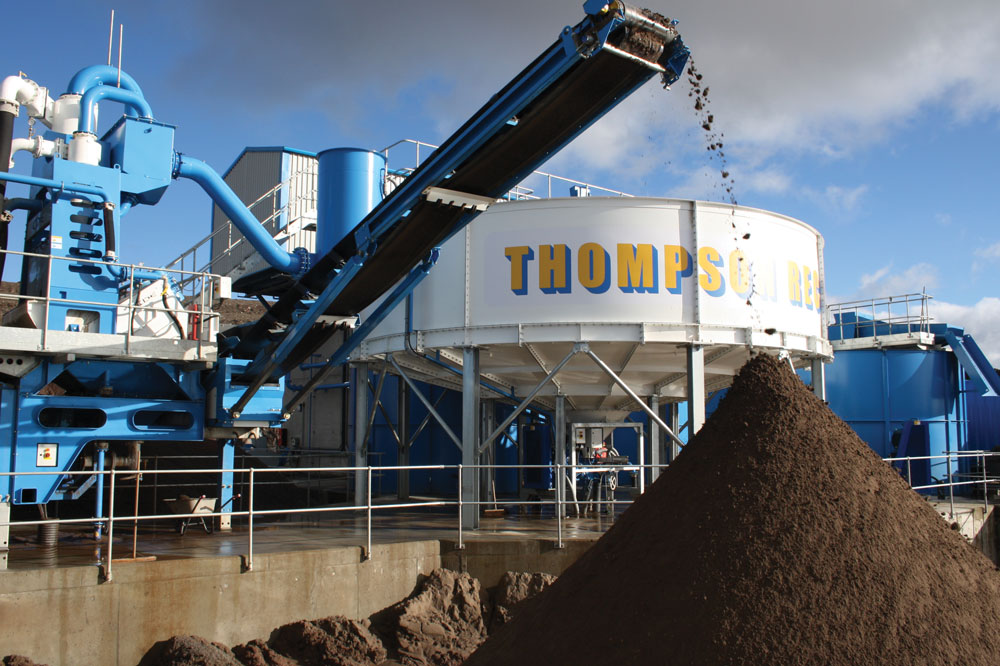
First published in the March 2017 issue of Quarry Management as Waste Not Want Not
William Thompson & Son turn landfill waste into sellable stockpile with new CDE washing plant
When most people look at an expanse of construction, demolition and excavation material, they see only waste. But Andrew Thompson, director of William Thompson & Son, sees things quite differently following the introduction of a CDE construction and demolition (C&D) waste recycling plant. ‘This material, which was once left unused, can now be washed, screened and sorted into a range of valuable products,’ he remarked.
William Thompson & Son have been in business for seven decades at their site in Dumbarton, Scotland. The company began in 1946 as a coal delivery and quarrying business. Today, having recently celebrated their seventieth year in business, they offer a wide range of products for the construction sector. The most recent addition to the Group is the Thompson Recycling & Landfill division, which recycles construction, demolition and excavation waste by way of a 120 tonnes/h wash plant installed in January 2016.
William Thompson & Son are able to supply the new C&D waste-recycling plant using material exclusively from their landfill site as well as imported material. The landfill site was the original Rigangower Quarry, which was later used for the disposal of construction and excavation waste. The C&D recycling plant is being used to turn these waste materials into a range of products with a commercial value. ‘We are able to recycle around 80% of the landfill material,’ said Mr Thompson.
Mainly supplying customers within a 30-mile radius of their Glasgow quarry, William Thompson & Son offer a wide range of new products from their C&D waste. The smallest aggregate is suitable for pipe bedding, the mid-range material is sold for closed drainage and the largest aggregates are suitable for open drainage. In addition, the site’s 0–4mm grit is in high demand for block making and the company also produces a 0–2mm fine sand and a concrete sand.
Project delivery
At the initial pre-sales stage, before any agreement was signed, CDE carried out detailed testing of the feed material and determined the capacity of the proposed plant to ensure that the models and options included would be best suited to the site. In this particular case, the feed material is very dirty given that it has been stored in a landfill for up to 25 years. In addition, it is very wet and sticky, making it even more difficult to process.
After consultation with the team at CDE, a fully integrated C&D plant was designed to suit the Thompson site’s specific output requirements. The plant comprises an R2500 primary screening unit, an AggMax 153R log-washer, an M2500 mobile wash plant, an AquaCycle thickener, and an overhead-beam filter press, complete with four water storage and sludge buffer tanks.
Commenting on his first foray into wet processing, Andrew Thompson said: ‘As our previous projects utilized dry crushing and screening, we carried out a lot of research into all the possible options. Given the complexity of the equipment and the difficult feed material, we knew that working directly with the manufacturer was going to be essential.
‘We opted for CDE because we know that they are not just selling this equipment, they are the manufacturer, and we see a lot of value in that: it means the same person who designed the plant can come to our site.’
As with all CDE projects, William Thompson & Son were assigned a dedicated project manager as a point of contact to ensure a successful installation and commissioning. Describing the design phase, project manager Ciaran Hegarty said: ‘We made use of a modular design that has been tried, tested and installed on many other projects worldwide. This also means that any spare parts are easily and readily available.’
The other benefit of the modular design was its quick installation time. But whilst the major plant items are modular, all the pipework and conveyors were custom designed to interlink seamlessly within the agreed plant layout, ensuring efficient transfer points and maximum material retention within the processing circuit.
Mr Hegarty continued: ‘It is part of my role as project manager to assess the site and create solutions to ensure efficient delivery and ongoing operation. Every site has its own issues but, based on our extensive experience, we always find a solution.’
One of the first considerations was power supply, as limited kilowatts were available from the local transformer. Rather than incur extensive costs to
Another issue on site was a limited supply of fresh water to supply the plant. However, as CDE’s modular systems are used across the world, they are designed to have minimal water requirements and this particular plant was designed to maximize water recovery and recycling through the use of an overhead-beam filter press.
With the efficient use and recycling of water, and the installation of the filter press, CDE have been able to reduce the plant’s water requirement to less than 15m3/h. The alternative to a filter press would have been settling ponds; however the steep hillside site was not suitable for such structures, which would have reduced the amount of water that could be recycled quickly back into the system.
One of William Thompson & Son’s key requirements was that the primary screening unit should be capable of meeting the company’s long-term plans for the site. To facilitate this, the R2500 has been designed with extendable hopper sides to allow for larger loads in the future. Andrew Thompson said: ‘We had originally considered the R1500, but we went for the R2500 as our long-term plan is that, as the nearby stocks are exhausted, we will be able to tip directly from lorries into the hopper.’
Another requirement of the company was that all the walkways should be interlinked, so that once an operator steps on to any section of the plant he can access all other parts of it. Ciaran Hegarty explained: ‘This is something that we were able to design into the plant to save operator time climbing up and down stairs on to different parts of the plant, thereby increasing operational efficiencies when carrying out essential plant inspection and maintenance work. Ultimately, this will help ensure that the company can meet production targets and customer supply by increasing the available production time.’
Throughout the project William Thompson & Son showed a commitment to finishing the installation to the highest standard. This was demonstrated in the approach they took to the civils requirements, where they went beyond the basic requirement of concrete pads and installed a raised concrete plinth on which the entire plant could be placed. This investment will have long-term benefits, including aiding operator efficiency, improving access to the machines for maintenance and ensuring a safe working environment, all of which should result in increased plant availability.
The process
Material is transported a short distance from the stockpile to the hopper of the R2500 primary screening unit by loading shovel, although the larger, extended feed bin will allow for the long-term plan to feed the unit by the lorry load. The primary screening unit, which scalps off all the +100mm oversize material, incorporates the latest screening technology in its Infinity P2 75R. This patented screen design includes huck-bolted construction, which removes the need for welds, and Trilogy sidewalls, which reduce the weight and result in a stronger, lighter screen that requires less power.
The –100mm material is transported by conveyor to the M2500 mobile wash plant where it passes an overband magnet on the feed conveyor before being discharged on to an Infinity screen for washing, sizing and sorting. The top deck captures all +40mm material, which is stockpiled as oversize, while the bottom deck captures the 4–40mm material, which is transferred by conveyor to the AggMax modular
log-washer.
Once in the AggMax, the clay-bound material is scrubbed clean and split into three washed products: 4–10mm, 10–20mm and 20–40mm. Any trash and lightweight organic materials are floated off from the rear of the AggMax where they are dewatered and discharged into a skip. Filtrates from both the trash screen and the sizing screen are pumped back to the M2500 for processing by the EvoWash cyclone section to produce two sands: 0–4mm and 0–1mm fine sand.
The waste water and fines from the cyclone are fed into the AquaCycle thickener where flocculent is added to aid the separation of the silts from the water, with the clean water being recycled into the Aquastore and the silts pumped into the sludge buffer tanks ready for processing by the filter press.
The plant incorporates four 100m3 capacity steel tanks, two of which are the sludge buffers that feed the filter press. These allow the wash plant to run at capacity while the tanks buffer the quantity of sludge produced, thereby removing the filter press as a major bottleneck in the overall processing capacity of the plant. Another tank is used as the main water recirculation vessel, storing all the water recovered from other parts of the wash plant process, ready to resupply the plant when needed. The final tank is a water storage buffer that allows William Thompson & Son to maintain the necessary top-up requirements, despite the fact that fresh water availability is limited.
Fed from the sludge buffer tanks, the overhead-beam filter press features 183 plates measuring 1.5m x 1.5m which operate on a press cycle to produce a dry cake material that can be removed by loading shovel. The use of a filter press allows a further 5% of the process water to be recycled back into the washing plant.
Customer for life
An integral part of CDE’s values is that customers are supported beyond the initial installation phase, to ensure the plant is maintained in proper working order and to allow customers to receive the maximum benefits from the plant.
Ciaran Hegarty explained: ‘For CDE, it is very important to maintain contact with our customers after installation and we really encourage setting up an ongoing maintenance schedule to ensure the plant can perform at its maximum effectiveness and to extend the life span of the plant.’
William Thompson & Son are subscribers to this idea and signed up for a two-year preventative maintenance contract that will see a member of CDE’s CustomCare team visit every quarter to carry out a review of the site, advising on any wear parts nearing the end of their life and ensuring the plant is running at optimum levels of productivity.
Andrew Thompson said: ‘Regular direct contact with CDE is something we really value. It gives us the confidence that we have everything in place to ensure the ongoing efficiency of the plant.’
Conclusion
William Thompson & Son have grown from a small operation into a large, dynamic business by constantly developing new markets and reinvesting in the available technology. And with the installation of the largest CDE C&D waste washing/recycling plant in the UK, they have further secured their position as an industry leader. ‘We are producing clean, high-quality recycled material that we are able to move very quickly,’ remarked Mr Thompson. ‘There is a growing acceptance of recycled products, and with the systems we now have in place, we are able to produce a large range of high-quality materials.’
- Subscribe to Quarry Management, the monthly journal for the mineral products industry, to read articles before they appear on Agg-Net.com

